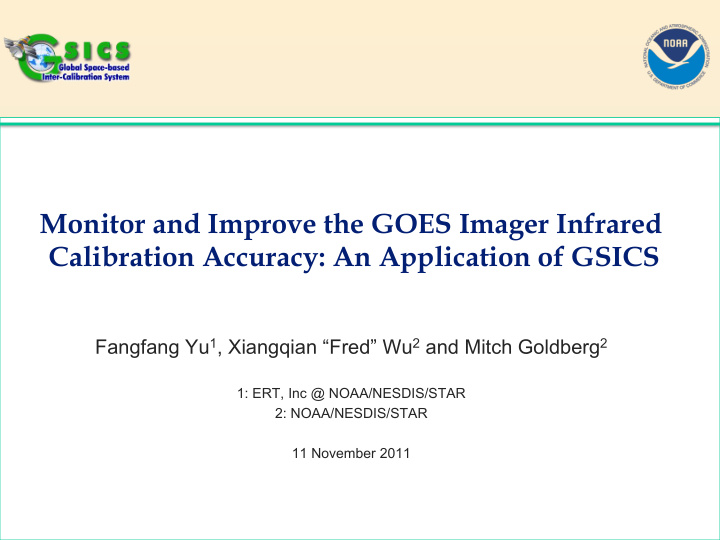



Monitor and Improve the GOES Imager Infrared Calibration Accuracy: An Application of GSICS Fangfang Yu 1 , Xiangqian “Fred” Wu 2 and Mitch Goldberg 2 1: ERT, Inc @ NOAA/NESDIS/STAR 2: NOAA/NESDIS/STAR 11 November 2011
GSICS GEO-LEO Inter-Calibration • Global Space-based Inter-Calibration System (GSICS) » International collaboration to improve and harmonize the operational satellite calibration accuracy through a variety of inter- calibrations » GEO-LEO inter-calibration to improve the GEO IR calibration accuracy • GEO-LEO Inter-calibration » Reference instruments: AIRS and IASI » Both radiometers are very stable – Negligible diurnal and seasonal calibration variation – Long-term stable since in-orbit – High spectral calibration accuracy – Very small difference radiometric between AIRS and IASI 2 NASA Sounder Science Team Meeting
Data Processing Flowchart MON Level 1 Data REF Level 1 Data Orbital Prediction 1. Subsetting Subset MON Data Subset REF Data Archive ~1 month Collocation • Spatial collocation Colloc. Criteria 2. Collocating • Temporal collocation • Viewing geometry alignment Collocated Data Archive ~1 month Transformation • Assume no in-orbit SRF change SRFs, PSFs, … 3. Transforming • JMA’s gap-filling method to fill the missing spectra Comparison Data Archive ~ 1 year Masks, flags, … 4. Filtering Analysis Analysis Data Archive ~ 1 year 3 NASA Sounder Science Team Meeting
Data Analysis Analysis Data Satellite Data Users Instrument Calibration Products Improvement of Correcting Monitoring/Diagnosing correction algorithm Reports/Tables Mon. L1 Data Corr. Coeffs Re-Cal Data /Figures GSICS GEO-LEO inter-calibration correction is traceable to IASI standard 4 NASA Sounder Science Team Meeting
GSICS GEO-LEO Correction Algorithm I a b * I = + GEO LEO a 1 I I = − + Correct GEO b b 5 NASA Sounder Science Team Meeting
GSICS Correction Result (1) 6 NASA Sounder Science Team Meeting
GSICS Correction Result (2) ¡ Before ¡Correc)on: ¡3K ¡Bias ¡ ¡ ¡ ¡ ¡ ¡ ¡ ¡ ¡ ¡ ¡ ¡ ¡ ¡ ¡ ¡ A2er ¡Correc)on : ¡ ¡~0K ¡Bias Tb difference between observed and calculated for GOES-12 Ch6 (13.3 µ m) before and after the GSICS correction Courtesy of T. Zhu 7 NASA Sounder Science Team Meeting
GSICS Correction Coeffs. • http://gsics.nesdis.noaa.gov:8080/thredds/catalog.html 8 NASA Sounder Science Team Meeting
GOES Diurnal Calibration Variation mean( Δ Tb GEO-AIRS , i ) –mean( Δ Tb GEO-AIRS, j ) GOES-11 Imager Ch3/4/5 Diurnal Cal. Variation 1.00 Diurnal Cal. Variation (K) 0.80 0.60 0.40 0.20 0.00 Ch3 Ch4 Ch5 winter (K) 0.18 0.79 0.71 Summer (K) 0.19 0.61 0.5 9 NASA Sounder Science Team Meeting
GOES-12 Calibration Monitoring 10 NASA Sounder Science Team Meeting Decontamination Events
Evaluation of Angular Dependent Scan-Mirror Emissivity Correction 11 NASA Sounder Science Team Meeting
SRF Revision • ITT revised the G13 Ch6 (13.3m) SRF during the PLT period. • NOAA shifted the SRF by -2.6 cm -1 with GOES vs AIRS collocated analysis data 12 NASA Sounder Science Team Meeting
SRF Revisions for GOES14/15 Ch3 (6.5 µ m) and Ch6 (13.3 µ m) • ITT revised the SRFs twice during the PLT period, but with still large simulated Tb biases • NOAA shifted the SRFs using GOES vs. IASI analysis data • New SRFs were implemented at the satellites on August 9, 2011. Bias before revision Bias after Revision GOES - GOES - GOES - GOES - AIRS IASI AIRS IASI G14 Ch3 +0.99 +0.97 +0.07 +0.10 G14 Ch6 -0.48 -0.55 -0.11 -0.12 G15 Ch3 +2.04 +2.12 -0.04 +0.00 G15 Ch6 +0.77 +0.74 +0.01 -0.02 9/23/2011 NASA Sounder Science Team Meeting
Summary • The well-calibrated hyperspectral sounding radiometers is very powerful in evaluating/monitoring/diagnosing the broad-band GOES IR calibration accuracy » Diurnal » Seasonal » Long-term » Scan mirror emissivity correction » MBCC performance » Improve the radiometric calibration accuracy • As the reference instruments, the instruments should have stable calibration accuracy at corresponding terms • The fundamental correction of the GOES midnight calibration anomaly using the GSICS data is undergoing … 14 NASA Sounder Science Team Meeting
Back-up 15 NASA Sounder Science Team Meeting
GOES Calibration Issues and Operational Remedies • Midnight Calibration Anomaly » Causes: – Extra radiation reflected by the BB to the detectors – Scattered solar radiation contamination at space view » Remedy: Midnight Blackbody Calibration Original calibration slopes of GOES-8 Correction (MBCC) Imager Ch2 (from Johnson et al. 1996) • Angular dependent scan-mirror emissivity » Absorptive feature of the Silicon dioxide (SiOx) coating to the scan mirror » Remedy: corrected with a 24-h scan view scan. 16 NASA Sounder Science Team Meeting
GOES-11 Calibration Monitoring 17 NASA Sounder Science Team Meeting
18 NASA Sounder Science Team Meeting
Recommend
More recommend